TikTok Search Ads are a new feature recently launched as part of TikTok’s advertising suite. And with the news that TikTok has recently added keyword targeting to it's Search Ad campaigns, TikTok might soon become a bigger part of your ad strategy than you think.
Despite being one of the newer social media platforms, TikTok’s popularity with users and advertisers has skyrocketed since its launch in 2016. Estimates suggest TikTok has a potential ad reach of more than 945m adults — growth of 14.6% since 2021.
TikTok is especially popular with retail advertisers. According to TikTok’s own statistics, the channel is now responsible for 15% of all product discovery. And this is just the beginning; TikTok ad revenue is projected to grow by almost 200% by 2027.
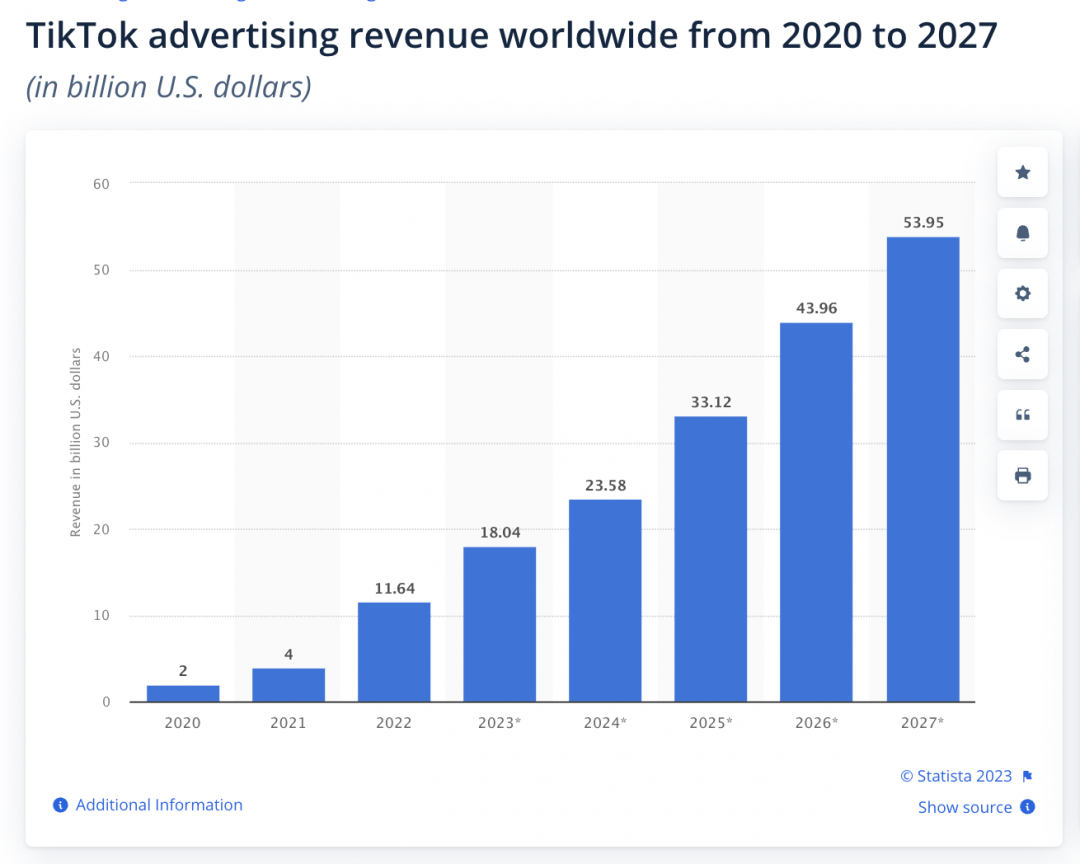
TikTok is particularly popular with younger users. Google has reported around 40% of 18-24 year old consumers take to TikTok or Instagram when they’re looking to buy, rather than Google platforms.
TikTok’s growth as an effective ad platform is backed up by its relatively low rates of invalid traffic (IVT). Our Wasted Ad Spend Report shows TikTok has the lowest rates of invalid traffic of all the social media channels we analysed:
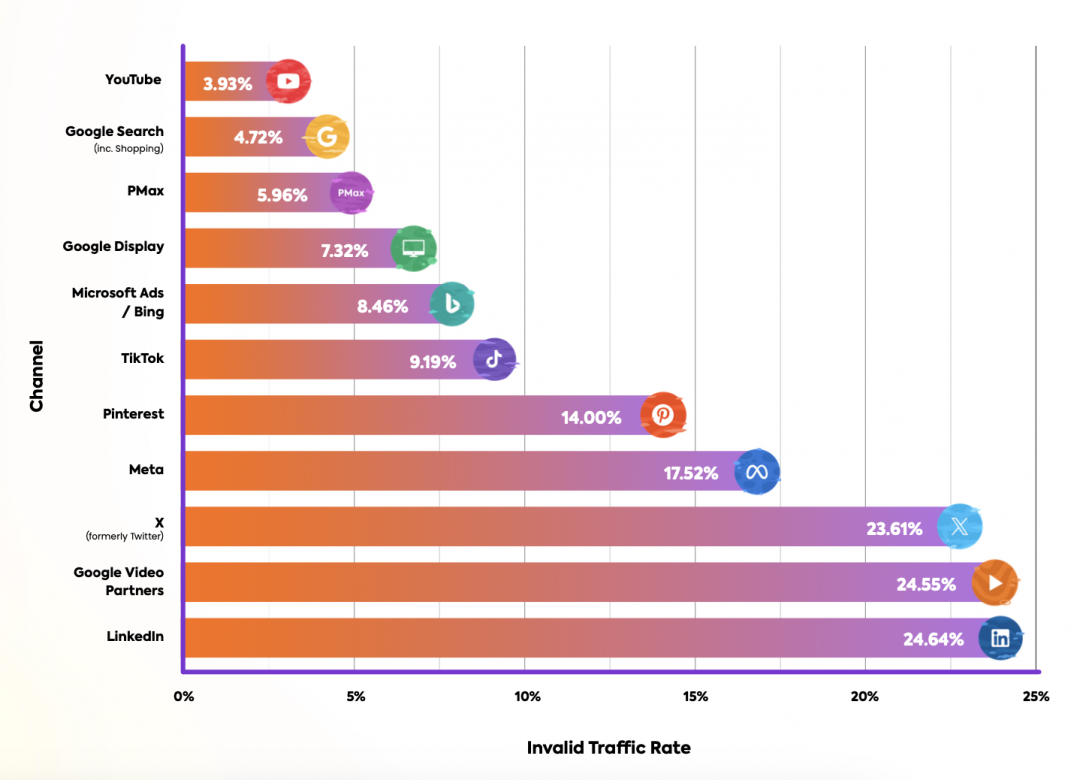
That said, TikTok still has an IVT rate of more than 9%. So performance marketers aren’t completely immune from IVT on TikTok. But you will waste less money here than on LinkedIn, X, or Meta platforms.
Note: To see which platforms are worst affected by invalid traffic, download our full Wasted Ad Spend Report 2024.
TikTok has huge potential for performance marketers, especially following the launch of TikTok Search Ads. Here, you’ll learn all about TikTok Search Ads, including how they work, why you should consider using them, the potential pitfalls, and what results you can expect.
What are TikTok Search Ads?
TikTok Search Ads offer a new way for brands to reach their target audience on TikTok by leveraging search intent. According the the platform’s documentation:
“With the Search Ads Toggle, brands can extend the reach of their campaigns to high-intent users who are seeking information relevant to their business, driving incremental engagement and revenue potential.”
Search Ads use your existing ad creative to display ads in search results, in addition to the current in-feed ad placements. When users search in TikTok, relevant ads are displayed as sponsored content, increasing your brand exposure among users with active purchase intent.
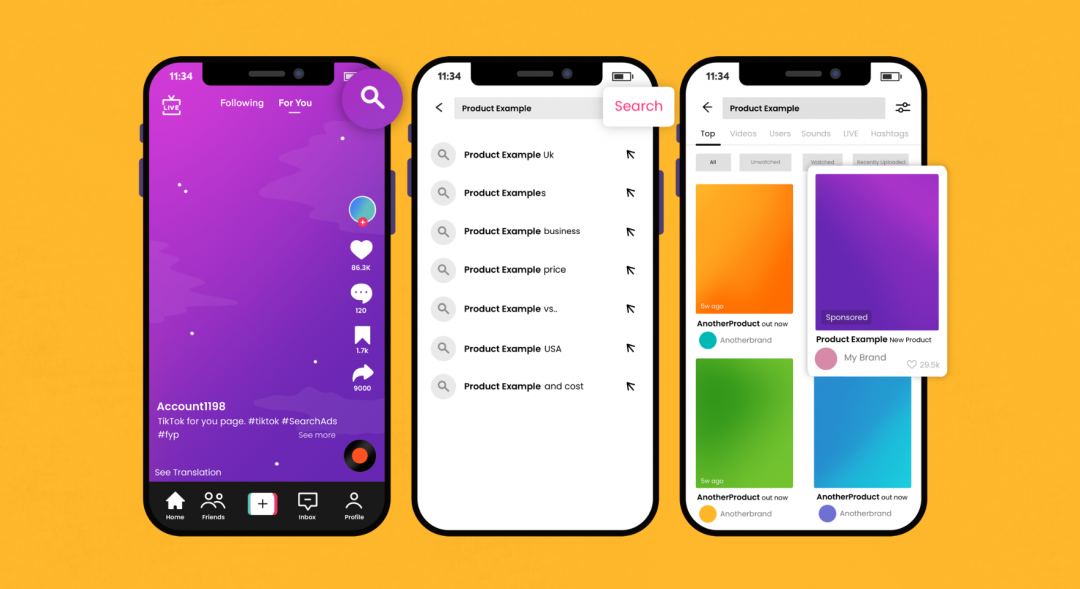
Reports suggest the Search Ads feature has already been successfully used by several brands. Kenny Gold, Managing Director and Head of Social, Content and Influencer Marketing at Deloitte Digital, says:
"It’s compelling, it’s a really nice, non-invasive version of search integration. The product feels simple. Not bad simple but easy to understand [kind of] simple. They’re leaning into discoverability, they’re leaning into the fact that they have a high, unduplicated audience from other social channels. It’s a good reach play. I think they want to really infuse it into the self-serve platform."
Kenny Gold
Head of Social, Content, & Influencer Marketing, Deloitte Digital
Keywords in TikTok Search Ad campaigns
In September 2024, TikTok announced revamped Search Ad campaigns, aiming to build upon the relative success of their previous Search Ads. The updated campaigns introduce a suite of new keyword-based features that bring their ad targeting capabilities much closer to that of Google Ads, including:
- Keywords - (although currently limited to only 20 keywords per Ad Group)
- Ad groups
- Bids - (with a recommended budget-to-bid ratio of 20:1)
Previously, TikTok Search Ads only allowed eligible ads to be shown in related search queries in the app. Unfortunately, advertisers couldn't target specific keywords, making TikTok Search Ads fairly limited in what they could offer.
The improved Search Ads are available for both traffic and web conversion objectives, and finally allow advertisers to select and target appropriate keywords for their campaigns. This gives advertisers significantly more intricate placement control compared to the previous iteration of TikTok Search Ads, bringing them much closer to other ad platforms in terms of functionality.
It's worth mentioning that while these campaign features are certainly a step in the right direction, they're not quite as fleshed out as some marketers had hoped. For example, no keyword match types have been announced, meaning marketers are likely to be using a universal match type decided by TikTok. Additionally, many marketers may find the 20 keywords per Ad Group limitation too restrictive.
Nonetheless, the addition of these new campaign features show TikTok clearly positioning themselves as major players in the search ad space. TikTok themselves stated:
"With Search Ads Campaign, brands have full control over how their content appears on the TikTok search results page, ensuring the right creative is served to the right users. Currently, Search Ads Campaign supports both Traffic and Web Conversion objectives, meaning that advertisers can optimize their campaigns for both scale and performance."
What marketers are saying about TikTok Search Ad campaign keywords
Leading Performance Marketing Specialist Thomas Eccel was one of the first to comment on the news via a LInkedIn post, where he mentioned that "TikTok Search Ads are for sure a real threat to Google":

Marketers were quick to comment their thoughts on the news, with Elmar Aga, VP of Paid Search @ MuteSix, mentioning that TikTok Search Ad campaigns may pose more of a threat to Amazon PPC than Google Ads:

Monde Austin Mtolo, Paid Media Specialist at Stratitude, made an interesting point. With TikTok's primary audience consisting of teenagers and young adults, it could take a long time for TikTok to capture considerable market share from Google:

Then, there's the elephant in the room. If TikTok owner ByteDance doesn't sell the platform within nine months, the platform could be banned in the US altogether - stifling the growth of TikTok Search Ads before they ever get off the ground. Talha Mumtaz, Growth Manager at Phiture, put it succinctly:

Web Analytics Consultant, Rasel Miah, made the valid point that the impact of TikTok Search Ads could be largely dependant on the tracking metrics they implement:

Neil Andrew, Founder & CEO of Lunio, commented on his own experience of using TikTok Search in a LinkedIn post, stating that TikTok "really did feel like the future of search":

All in all, opinions on the new campaign targeting features are largely positive, with some trepidation on how they will perform vs. Google Ads - and speculation on just how much market share they will take from Google.
Back in 2018, some marketers thought the release of Facebook Search Ads would significantly harm Google. Yet stats show that 6 years later, Google still holds on to a very healthy advantage when it comes to digital advertising market share. Could TikTok Search Ads just be a case of history repeating itself?
Ultimately, only time will tell just how effective TikTok Search Ad campaigns will be. The updated Search Ad campaigns are currently live in the US, with an EU date yet to be announced at the time of writing.
How to turn TikTok Search Ads on and off
Search Ads are turned on and off using the Search Ads Toggle, which can be found under the Placements section in TikTok Ads Manager:
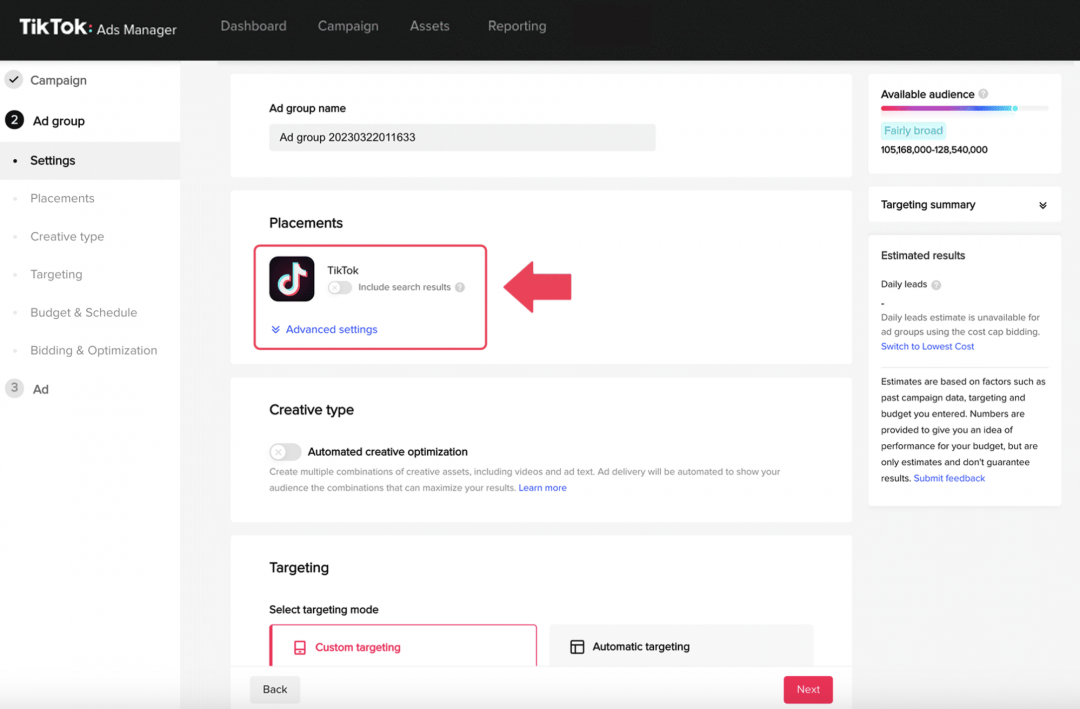
By default, the Search Ads Toggle is switched on. So if you don’t want your ads to appear in search results, you’ll need to switch this off.
You can activate the toggle when you create the campaign, or at a later point. However, if you switch it on after you’ve created the campaign, the campaign learning phase won’t be reactivated.
With the Search Ads Toggle switched on, your search ads will be created and served automatically. According to TikTok’s release information:
“By keeping the toggle set to "on," search results ads will be automatically created using the advertiser's existing In-Feed Ad content and targeting, and served against relevant user queries adjacent to organic video results.”
Enhance brand safety by adding negative keywords
Fortunately, TikTok has enabled advertisers to add negative keywords to prevent ads appearing for searches that don’t align with their brand values.
This focus on brand safety makes TikTok a safer platform to advertise on than, say, X (formerly Twitter). X has recently joined Google Display Network, causing brand safety concerns among advertisers due to the often-controversial material shown on X (not to mention X’s prolific bot problem).
Maximising ad visibility: Hashtags and descriptions
As ads are served against relevant user queries, it’s really important to pay attention to the hashtags and video descriptions you use. If you're not using the updated campaign features to target specific keywords, TikTok will use your hashtags to match your ad creative to searches. Therefore, using the wrong hashtags and words could mean your ads aren’t shown to a relevant audience.
To help the algorithm serve your ads for the right search queries, add keywords you want your ads to be shown for as hashtags and as part of your video description. Adding these doesn’t guarantee your ad will be served, but it will help TikTok learn when to show your ads in its search results.
Whether you're using specific keywords or relying on TikTok's algorithm via hashtags, the same rules apply. Avoid keyword stuffing, as it doesn’t make your ads any more likely to be served. Instead, aim to add three of the most relevant search terms as hashtags and description keywords per video.
TikTok Search Ads benefits
The main advantage of TikTok Search Ads is that you can reach users showing active intent to buy. This is a massive benefit for retail advertisers, as with the right content and bids, you can capitalise on real-time purchase intent.
For this reason, Search Ads arguably have more value than in-feed ads. In-feed ads are displayed to passive users who don’t necessarily have any inclination to make a purchase. This can boost brand awareness, but you won’t necessarily make as many sales using this approach.
Searches indicate an active interest in a topic, product, or service, making it far more likely that users will convert on seeing a relevant ad. Andres Bustamante, Senior Media Buyer at Linx Digital, says:
"If people are searching for a specific item or different results related to your product or service, that’s very powerful. It’s more than just putting content out there for entertainment purposes or creating value. You can now place these ads to monetise and get a return on investment for what you’re promoting.
Capitalising on user search intent leads to greater return on investment. As shown in the case studies below, advertisers have already seen improved performance using TikTok Search Ads compared with in-feed ads alone."
Andres Bustamante
Senior Media Buyer, Linx Digital
TikTok Search Ads: case studies
Early adopters of TikTok Search Ads have seen promising results. Take a look at two case studies highlighted by TikTok to showcase the potential of their Search Ads feature.
1. Clinique increases click through rate by 51%
If proof is needed that Search Ads are better for ROI than in-feed ads, Clinique provides it. Using TikTok Search Ads resulted in 74,000 incremental search impressions, a 441% conversion rate increase.
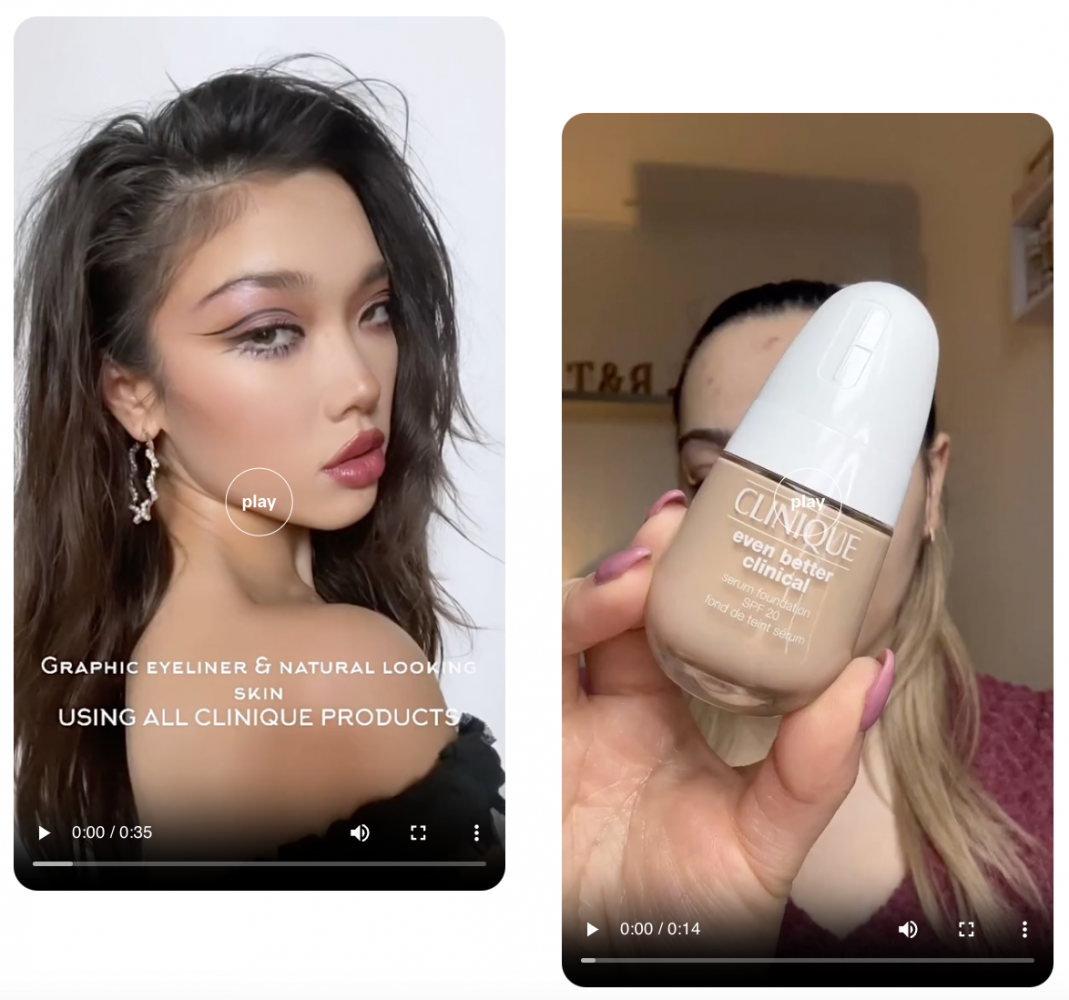
Post-campaign research also found a 7.4% increase in ad recall among users, indicating search users found the campaign more memorable. Following these results, Clinique plans to switch on TikTok Search Ads for all its eligible campaigns.
2. DIBS Beauty lowers cost-per-acquisition by 22%
Beauty brand DIBS used TikTok Search Ads to demo a product during a Black Friday/Cyber Monday campaign in 2022. The campaign resulted in an 8% increase in conversions, and a conversion rate six times higher than in-feed ads alone.
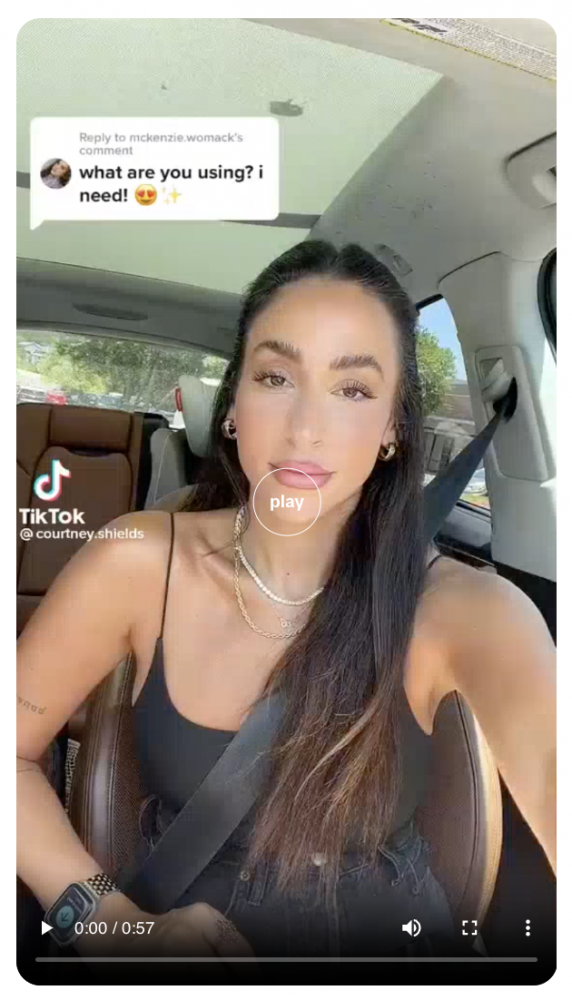
Search Ads also led to a significant decrease in cost-per-acquisition, lowering costs by 22%. So simply flipping TikTok’s Search Ads switch can offer huge benefits for retailers, especially around peak shopping season.
Protect TikTok Search Ads with Lunio
The introduction of TikTok Search Ads is game-changing for retailers and e-commerce brands, especially those who already have a robust TikTok ads strategy. But to get the most from your TikTok campaigns, advertisers must protect their ads from invalid traffic.
Lunio protects both TikTok Search Ads and in-feed ads, helping you get the best possible return on your ad spend. Trial Lunio free for 14 days to see how much invalid traffic is infiltrating your TikTok campaigns.



